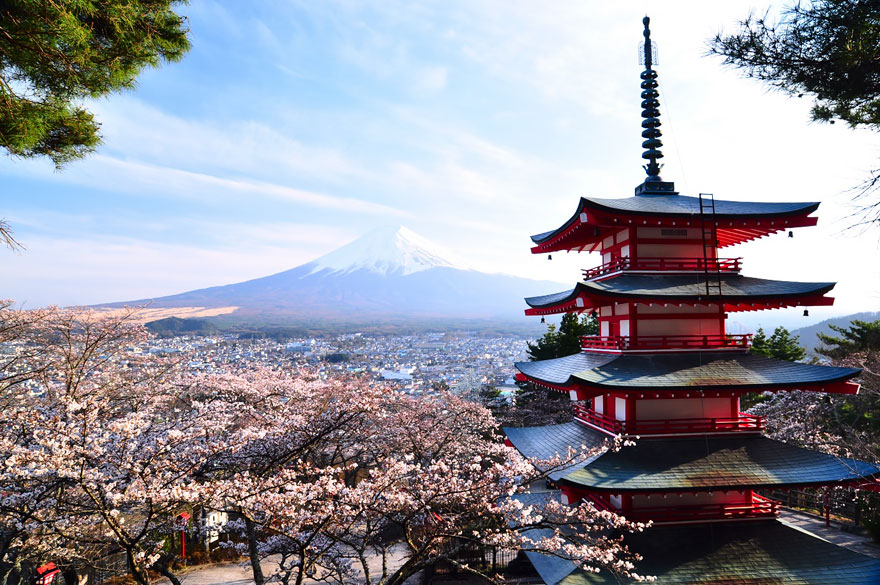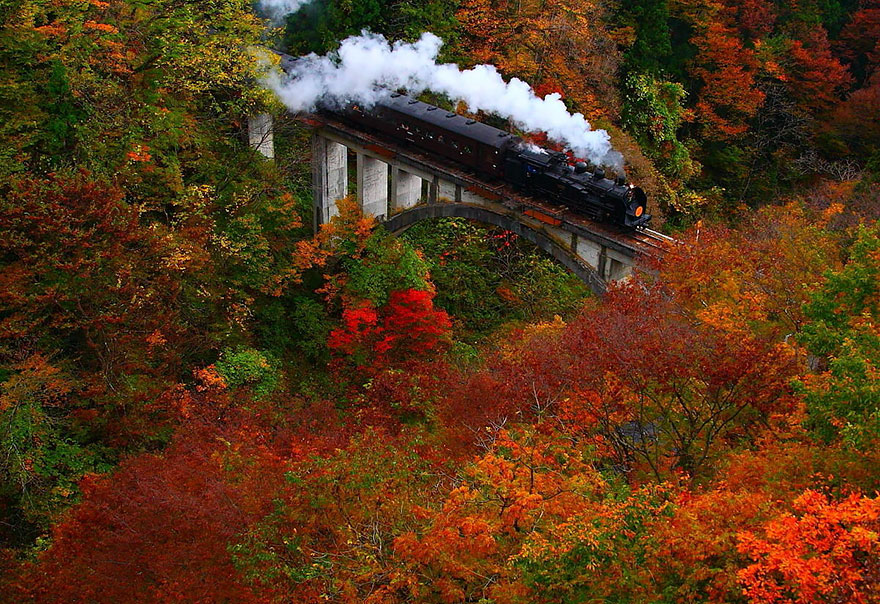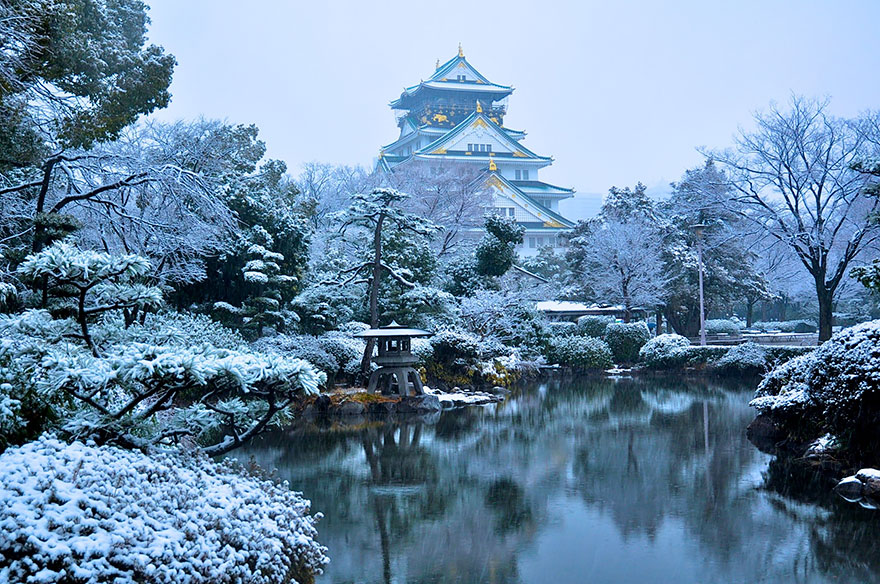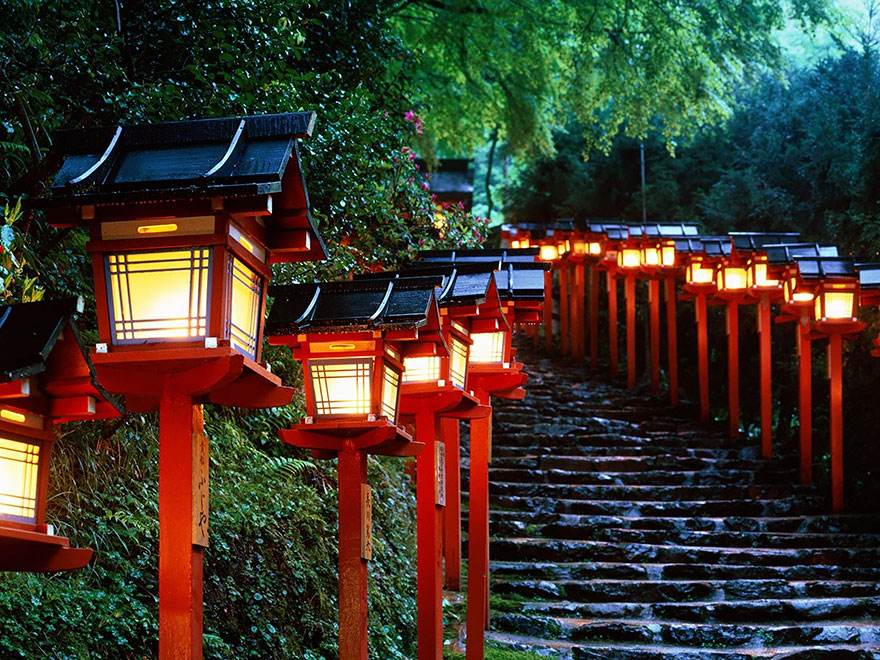If you've ever visited Japan then you'll know how amazing it is. And if you've never been before then what are you waiting for?! Check out this list compiled by Bored Panda. In it you'll find some of the very best sights that this fascinating country has to offer. Some of them are familiar tourist spots. Others are more remote. And a couple are off the map altogether. But believe us when we say that all of them are awesome.
This post may include affiliate links.
Sagano Bamboo Forest, In Arashiyama
There's a reason that Sagano Bamboo Forest ranks as one of Bored Panda's favorite places in the world. What we can say, we love bamboo! We are pandas after all. But even we wouldn't dream of munching on this beautiful forest situated in Arashiyama, the second-most popular tourist district in Kyoto. Walking through the towering bamboo groves is like being transported to another world, and even though it can get pretty crowded, especially during high season, there's no denying that Sagano Bamboo Forest is a must for anybody visiting the region.
Autumn In Hitachi Seaside Park
Autumn is the best time to visit Hitachi Seaside Park, a popular park on the east coast of Honshu, Japan's biggest island. It takes about two hours to get there via public transport from Tokyo, making the park an ideal location for a day trip for those looking for a brief respite from the hustle and bustle of the capital.
4.5 Million Baby Blue Eyes In Japan’s Hitachi Seaside Park
Hitachi Seaside Park, situated north east of Tokyo, is a perfect place to visit at any time of the year thanks to its abundance of season flowers that turn the landscape into a colorful canvas. September is the best time to visit, as that's when most varieties are in bloom, but if you want to see these Baby Blue Eyes (otherwise known as Nemophilia) then be sure to visit during April and May.
Wisteria Tunnel At Kawachi Fuji Gardens
Ever wanted to walk through a Wisteria tunnel? Then you're in luck, because Kawachi Fuji Garden has just what you're looking for. The garden is located in the northern tip of Kyushu island, about an hour from Fukuoka via public transport. The Japanese love Wisteria (don't we all?) and the flower even features in Waka, a classic Japanese poem. The best time to visit the Garden is in late April when the flowers are at their most colorful.
Fields Of Shibazakura
The Fuji Shibazakura Festival is an annual event that celebrates the vibrant Shibazakura moss that grows in the Fuji Five Lakes area. Visitors to the festival will be greeted with a stunning sight: over 800,000 stalks of pink, white and purple moss covering field after field stretching towards the magnificent site of Mount Fuji in the background. The best time to see the moss varies every year but the festival is usually held between April and June. Visibility is best in the early mornings.
River In Kawagoe
If you're spending some time in the Toyko area then be sure to put a day aside to visit Kawagoe. The city can be reached in only 30 minutes by train, making it the perfect destination for a day trip. Kawagoe is well known for its rivers (Kawa means "river" and Goe means "over") and is often referred to as "Little Edo" because the main street is said to retain the ambiance of the town during the Edo Period (1603-1867). Try scheduling your visit to coincide with the Kawagoe Festival, help for two days on the 3rd Saturday and Sunday of October.
Fushimi Inari-taisha
Fushimi Inari Shine is one of the most important Shinto shrines in southern Kyoto. It's also the most important shrine dedicated to Inari, the Shinto god of rice. Foxes are believed to be Inari's messengers, which is why you'll find plenty of fox statues around the shrine. The main draw for tourists however are the thousands of vermilion torii gates that straddle the various winding trails around the main buildings. It's an awesome place for photography enthusiasts, as long as you get there before the crowds...
Nakasendo Walk
The Nakasendo Way is a walking route that begins in Kyoto and ends in Edo. Nakasendo literally means 'the road through the mountains' and it was an important transport route in the 17th Century. Now largely forgotten, the Nakasendo Way provides a pleasant, scenic walk though both the countryside and the history of Japan. The entire journey takes around 10 days is suitable for anybody who can comfortably walk for more than three or four hours at a time. Various tour operators offer packages including guides, food, and accommodation.
Natadera Temple In Winter
Natadera temple is a beautiful sight at any time of the year, but no season does justice to this ancient holy site quite like winter. The temple is over 1300 years old, having been founded in 717 by a Buddhist monk who visited a nearby mountain in search of a goddess. Both the mountain (Mount Hakusan) and the temple remain the the region's most popular sites of worship today.
The Pagoda Of Seigantoji And Nachi No Taki Waterfall
If you're looking for ancient history combined with breathtaking scenery then don't miss the Pagoda of Seigantoji. Located in Wakayama Prefecture, Higashimuro, the pagoda is three stories high and makes for an impressive sight by itself. But the fact that it sits beside Nachi no Taki, Japan's talling waterfall, makes it even more spectacular! The waterfall is 133 metres high (over 430ft) and was the original religious site of the area, and it's easy to understand why people chose to worship this awesome natural wonder when you see this magnificent sight for yourself.
Bamboo Light Festival In Taketa, Ōita
Taketa means bamboo and rice field, and what better way to celebrate the city's heritage with a bamboo light festival! The tradition was started in 2000 as a way of helping to regulate the rapidly growing bamboo that you can find all around the region, and the festival attracts tourists from all over the world who are keen to witness the 20,000 lanterns that go on display for three nights every year. The festival begins on the third Friday of November.
Rainy Day In Osaka
Whether the sun is shining or it's pouring with rain, there's always something to do in Osaka. the city is Japan's second largest metropolitan area after Tokyo and is well known for its striking architecture, rowdy nightlife, awesome street food, and, of course, Osaka Castle. If the weather is bad then don't worry because in the middle of the city's main shopping district is Shinsaibashi-suji, a large covered shopping street where you can easily spend a few hours while you're waiting for the rain to stop.
Blue Pond In Hokkaido
Hokkaido is the second largest island of Japan. Situated in the far north, it's a vast and relatively untouched wilderness approximately 40 times bigger than Tokyo but with only a third of the population. If you're planning to visit this enchanting region then be sure to check out the Blue Pond (Aoiike), named so because of the natural minerals that turn the water into a beautiful blue lagoon. You can find it on the outskirts of Shirogane Onsen, a hot spring town in Kamikawa District.
Cherry Blossoms Paint A Lake Purple In Tokyo
Japan's Cherry Blossom is one of the most spectacular seasonal sights that the country has to offer. Every spring the country turns into a huge bouquet of pastel colored petals, but if you want to witness it for yourself then make sure you time it right because cherry blossom season lasts only a few weeks. Fortunately there are several websites dedicated to monitoring each year's blossom, so keep an eye on their updates in order to ensure your visit is perfectly timed.
Chureito Pagoda And Mount Fuji
If you're planning a visit to Japan then no itinerary is complete without a glimpse of the country's most famous natural wonder. One of the best views of this spectacular mountain can be had from Chureito Pagoda, a peace memorial built in 1963. You'll need to climb about 400 steps to reach it, but believe us when we say that every step is worth it.
Aogashima Island
If you're looking for adventure then look no further than Aogashima Island. Situated in the Philippine Sea over 350km south of Tokyo, the only way to get there is by helicopter or by boat. The island, which covers an area of less than 9km2 and houses fewer than 200 inhabitants, is most well known for its unique geological formation. Not only does Aogashima have a volcanic crater at its centre - the crater is actually situated in the middle of a second, larger volcanic crater! The result is both beautiful and awe-inspiring, and whoever braves the long journey to Aogashima Island will be rewarded with a truly memorable experience.
Autumn Color In Fukushima
When people think of Fukushima, they probably think of all the wrong things. In 2011 the region was hit by a devastating earthquake that triggered a tsunami, the impact of which was the meltdown of a major nuclear power plant. However, while people are still advised to keep at least 20km away from the remains of the power plant, most of the region remains unaffected and has a huge amount to offer tourists. Autumn is especially beautiful, so be sure to stop off here if you're planning on heading north.
Keage Incline In Kyoto
The Keage Incline is situated at the Kyoto end of Biwako Canal. It was once an important transport route during the Meiji Era, and the remnants of an old railroad still remain to this day. The disused train tracks beside the canal are a perfect place for a stroll, especially when the cherry blossom is in bloom, and the area is popular with tourists as well as locals because if its scenic and peaceful location. There's a free museum for anybody interested in the canal's history, and there's also an old red brick aqueduct nearby worth visiting.
Osaka Castle Blanketed With Snow
A trip to Osaka isn't complete without a visit to its famous castle. It's one of Japan's most famous landmarks and played a major role in the unification of Japan during the 16th Century. The castle grounds cover approximately 60,000 square metres and the views from the main tower offer you a breathtaking panorama of the surrounding city.
Bioluminescent Firefly Squid Illuminate The Toyama Bay
There are many reasons to visit Toyama, but if we were to give you only one we'd have to choose the Firefly Squid that illuminate Toyama Bay. It's one of the largest bays in Japan and every year it turns into one of the world's most amazing natural spectacles, when thousands of Firefly Squid emerge from the depths and surface to spawn on the shore. Toyama prefecture lies north-west of Tokyo and you can reach it in 3-4 hours by train. Even if it took twice the time to get there, believe us when we say that the journey is more than worth the effort.
Fireflies At The Bamboo Forest
There are many reasons to visit Nagoya, one of which is to visit the famous Nagoya castle. Another amazing reason to visit however is the mesmerizing firefly displays that you can find around the city. Nayoga is a well-known place to witness this spectacle, and although you can't see it every day, those that do are rewarded with a natural light show unlike any you've ever experienced.
The Guardian Of Todai-ji In Nara
Todaiji means the Great Eastern Temple and it's one of Japan's most well-known and historically important temples. In fact, Todaiji's main hall, the Daibutsuden (Big Buddha Hall), is actually the world's largest wooden building! The temple is a major landmark in Nara, a city located in south-central Honshu that's famous for its abundance of wild deer that patrol the streets and parks at their leisure. You can feed them with deer crackers that you can buy all over Nara, but be warned: once the deer know you have food, expect to be followed around the park until all of it is gone!
Tokyo At Night
Tokyo is almost like two cities in one. There's daytime Tokyo, and there's night-time Toyko, and if we had to choose which was best then we'd go for the second every time. Once the sun sets the capital transforms into a surreal, spellbinding and sensory-overloading wonderland of neon lights, bustling streets, crowded bars and condensated windows. The same description could be applied to many cities around the world, but experience night-time Tokyo for yourself and you'll understand that there's literally nowhere on earth like Japan's enchanting capital.
Cherry Blossoms Swirl Around The Osaka Castle
Witnessing the beauty of the annual cherry blossom and experiencing the majestic grandeur of Osaka Castle are two of the most amazing experiences for anybody visiting Japan. Why not combine these unforgettable attractions by making a trip to Osaka during the cherry blossom season? The flowers bloom around March/April every year, but be sure to double check the exact dates before you book your flight.
Tea Garden Near Mt. Fuji
Tea plays an important role in traditional Japanese culture. Green tea is the most commonly consumed beverage in Japan and it's often drank in a powdered form known as matcha. It first arrived from China over 1300 years ago and the Japanese have been in love with it ever since! You can't visit the country without trying a cup for yourself, and if you're looking for a unique Japanese experience then we'd suggest sitting in on a traditional tea ceremony. Better still, why not visit one of the country's tea farms? You can find many of them in Shizuoka Prefecture, which is also the home of Mount Fuji, and there's no better way to enjoy a cup of Japan's favorite beverage than while gazing upon the country's most iconic mountain.
Shirakawa Village
Shirakawa Village is located near Gokoyama village (also in this list) and is one of Japan's many UNESCO World Heritage Sites. The site make a perfect day trip from Takayama and Kanazawa, although for those looking for a more traditional experience, it's also possible to stay overnight at one of the characterful farmhouses in the village.
Red Autumn In Kyoto
Kyoto needs little introduction. It was the country's capital and the site of the emperor's residence from 794 to 1868, it's the city in which the famous Kyoto agreement was signed, and it's an absolutely treasure trove of Japanese history, culture, architecture and religion. In fact, due to Kyotos massive historical significance, the city was dropped from a list of possible targets for the atom bomb that brought WWII to an end. If you only visit one city in Japan, make that city Kyoto. Try going in the autumn when the leaves turn the city into a fabulous mosaic of oranges, yellows and reds.
Daigoji
Daigo-ji is a Buddhist temple located in Fushimi-ku, Kyoto. Daigo literally means "ghee" and is used as a figurative way of saying "crème de la crème", which is a metaphor for the profound purity of Buddhist thought. The temple is an important site for the Shingon sect of Japanese Buddhism and is one of the country's many World Heritage Sites. You can reach Kyoto from Tokyo in approximately 3-4 hours by train.
Meigetsu-in Temple
Meigetsu-in Temple was built in 1160. It is also known as the Hydrangea Temple because Hydrangeas bloom in abundance during rainy season. The temple was originally built by a son in memory of his father who died during the power struggles between warring clans in the late Heian Period. It's situated in Kanagawa Prefecture and can be reached on a day trip from Tokyo.
Gokayama Historic Village
After China, Japan has more UNESCO World Heritage Sites than any other country in East Asia. The country has 19 in total and the historic village of Gokayama is one of them. The site comprises both Gokayama village and Shirakawa-gō village (also in this list), and it's located in the Shogawa river valley. The villages are famous for their traditional "Gassho-zukuri" style of houses, which means "constructed like hands in prayer". Some of them are more than 250 years old.
Tanada in TOKUSHIMA. 88 Shikoku pilgrimage walk in SHIKOKU ISLAND are also special beautiful place
Kifune Shrine Located At Sakyō-ku In Kyoto
Kifune Shrine is a Shinto shrine found in Kyoto. It's also often called Kibune Shrine. Kibune means yellow boat because according to legend, a goddess traveled in a yellow boat all the way from Osaka, and the shrine was built at the place where her journey came to an end. The shrine is dedicated to the god of water and rain, and visitors can obtain a special type of written fortune that reveals their secret messages only when dipped into water.
Terraced Fields In Saga
Saga Prefecture is located on the north-west of Kyushu Island. It's a long way from both Tokyo and Osaka and it certainly isn't a popular stop on the typical tourist trail, but those who venture this far out will be glad that they did so. The Prefecture is famed for its beautiful rice terraces that cascade down the mountains towards the ocean, and when the sun sets they shine in the moon like broken mirrors of shards of glass. You can fly to Saga in 2 hours from Tokyo, but if you have the time then take the train and stop at Osaka, Kyoto and Hiroshima in order to experience the very best of what this part of Japan has to offer.
Blooming Cherries
Have we mentioned the cherry blossom yet? Probably, but still, just in case we haven't, there's no experience more Japanese than seeing the country's amazing cherry blossom for yourself. The best time to see this spellbinding spectacle is around March/April, but as the season changes ever year, be sure to check exact dates before booking your flights.
Spring In Japan
Few countries do spring like Japan does spring! While the country has plenty to offer tourists all year round, the best time to go is most definitely when the cherry blossoms are in bloom. Prices are higher around this time as people flock from all over the world to see this magnificent sight for themselves, but despite the costs, and despite the crowds, there's no denying that spring in Japan is one of the most amazing experiences you can have. Don't forget your camera!
Snow Falling On Kabukicho
If you're going to Tokyo then no trip is complete without a visit to Kabukichō, an entertainment and red-light district in Shinjuku and one of the largest red-light districts in Japan. The area is located on the eastern side of Shinjuku train station and is totally safe for foreigners to explore. The district is full of hostess clubs, love hotels, nightclubs, and shops, and it's often known as the "Sleepless Town" for reasons we probably don't need to explain!
Mimurotoji Temple
Mimurotoji, also known as the "flower temple", is situated in the northern hills of Uji city. It's easily reachable by train from Kyoto station and it's definitely worth a visit should you happen to be in the region. The temple is approximately 1200 years old and its gardens offer a fantastic array of different flowers depending on the season. Visitors can find cherry blossom in early April, Azalea in May, Hydrangea in June, and Lotuses in July and August.
Tokyu Plaza
There are many shopping malls in Tokyo but few can complete with Tokyu Plaza. The shopping complex is based in the Shibuya area of the capital and it's probably most well known for its striking entrance. The escalator travels through a tunnel bedecked with hundreds of mirrors that are all positioned at different angles to create a multitude of mind-bending reflections. It's something that needs to be seen to be believed, and it's a great spot for some fun photography. Another awesome reason to visit Tokyu Plaza is the lush public park that you can find on the roof.
I lived in Japan for 2 years. I loved every second of it. Hopefully I can go back with my family and live there a few more years. I have a number of friends that stayed in Japan and have successfully integrated into this beautiful culture with amazing people.
I lived in Japan for 2 years. I loved every second of it. Hopefully I can go back with my family and live there a few more years. I have a number of friends that stayed in Japan and have successfully integrated into this beautiful culture with amazing people.

 Dark Mode
Dark Mode 

 No fees, cancel anytime
No fees, cancel anytime 

















































































































